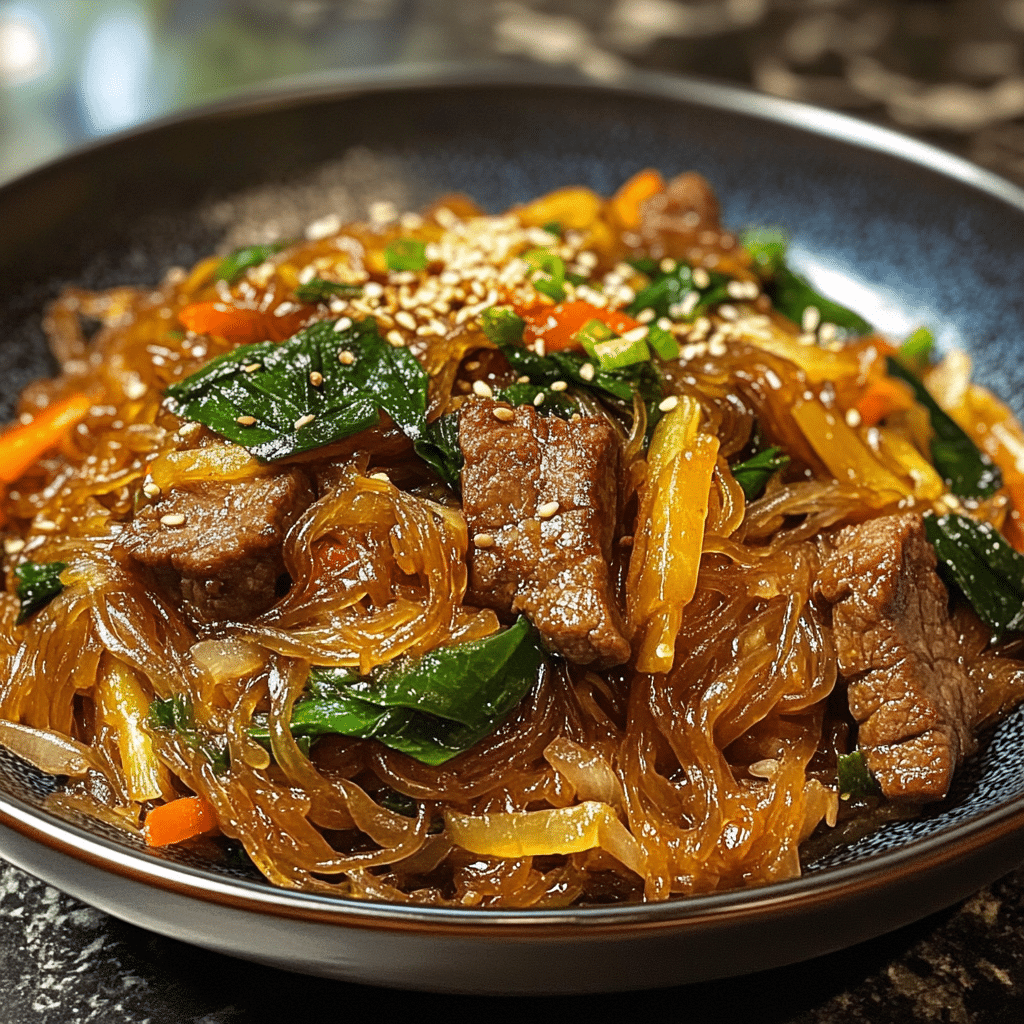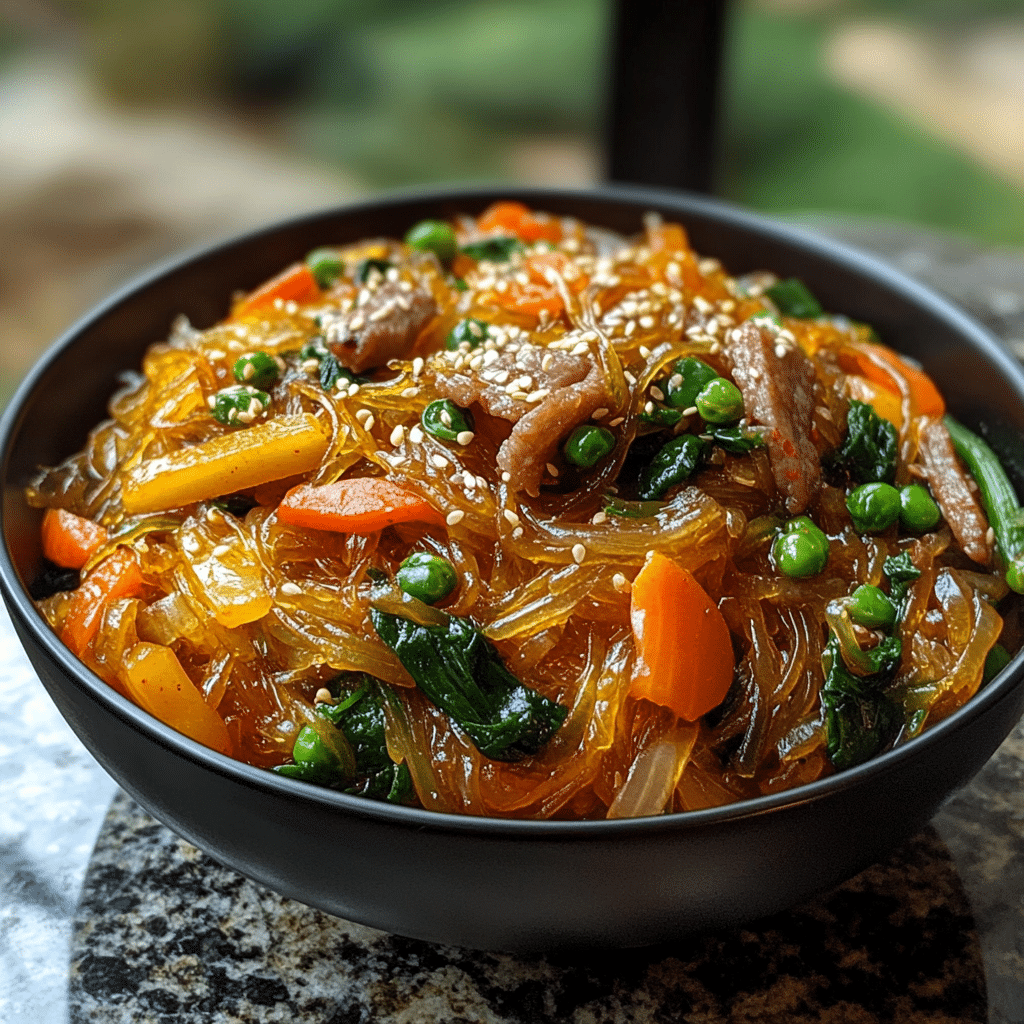Japchae is a beloved Korean dish that features a delightful mix of tender beef, colorful vegetables, and chewy glass noodles, all coated in a savory-sweet sauce. This savory stir-fry is not only flavorful but also highly versatile, making it an excellent choice for family dinners, gatherings, or meal prep. The dish is known for its beautiful presentation, with vibrant vegetables like carrots, onions, and spinach contrasting with the glossy noodles, while the beef adds a rich, savory depth. With a few simple ingredients and a straightforward cooking method, Japchae is a dish that anyone can easily make at home and enjoy.
The glass noodles in Japchae, made from sweet potato starch, are naturally gluten-free and provide a satisfying chewiness that absorbs the delicious sauce. The soy sauce, sesame oil, and brown sugar create a perfect balance of umami, richness, and subtle sweetness. While this recipe calls for beef, you can easily substitute it with chicken, tofu, or shrimp to suit your dietary preferences. Japchae can be served hot or cold, making it a versatile dish suitable for any occasion.
Why You’ll Love This Recipe
Japchae is a flavorful and satisfying dish that brings together tender beef, soft noodles, and a variety of vegetables, all cooked in a deliciously balanced sauce. The glass noodles absorb the sweet and savory flavors of the sauce, making every bite full of taste and texture. What makes this recipe even better is how customizable it is—whether you prefer to use chicken, shrimp, or tofu, the dish can easily be adapted to suit your tastes. It’s quick to prepare and ideal for both special occasions and weeknight dinners. Plus, it’s naturally gluten-free when using tamari, so everyone can enjoy it!
Ingredients
- Thin-sliced beef (or substitute with chicken, tofu, or shrimp)
- Korean sweet potato noodles (glass noodles)
- Carrots
- White onion
- Green onions
- Garlic
- Fresh spinach leaves
- Sesame oil
- Olive oil
- Soy sauce (or tamari for gluten-free)
- Brown sugar
Variations
- Protein Swap: Replace the beef with chicken, tofu, shrimp, or even a combination of proteins to suit your preferences or dietary needs.
- Vegetarian Option: Omit the meat and increase the amount of vegetables for a fully vegetarian dish. Tofu can be used as a protein substitute.
- Spicy Japchae: Add some chili flakes or a dash of gochujang (Korean chili paste) to the sauce for a spicy kick.
- Additional Vegetables: Include bell peppers, mushrooms, or zucchini for extra flavor and texture.
- Gluten-Free: Use tamari instead of regular soy sauce to make this dish gluten-free.
How to Make the Recipe
Step 1: Cook the Noodles
Bring water to a boil in a large pot, adding a drizzle of olive oil. Add the sweet potato noodles and cook for 5-6 minutes until tender. Drain the noodles and set them aside.
Step 2: Cook the Beef
In a skillet over high heat, cook the thin-sliced beef until browned. Season with half of the soy sauce, sesame oil, and brown sugar while cooking. Once cooked, set the beef aside.
Step 3: Cook the Vegetables
In another skillet, heat the olive oil over medium-high heat. Add the julienned carrots and sliced onion, cooking until softened, about 4-5 minutes. Add the remaining soy sauce, sesame oil, and brown sugar. Stir in the garlic and chopped green onions and cook for another minute.
Step 4: Add Spinach
Add the spinach leaves to the skillet with the vegetables and stir until the spinach wilts, about 2 minutes.
Step 5: Combine Everything
Add the cooked beef and vegetables to the noodles in a large mixing bowl. Toss everything together well, making sure the noodles are evenly coated with the sauce and combined with the beef and vegetables.
Step 6: Serve
Serve the Japchae warm and garnish with additional green onions if desired.
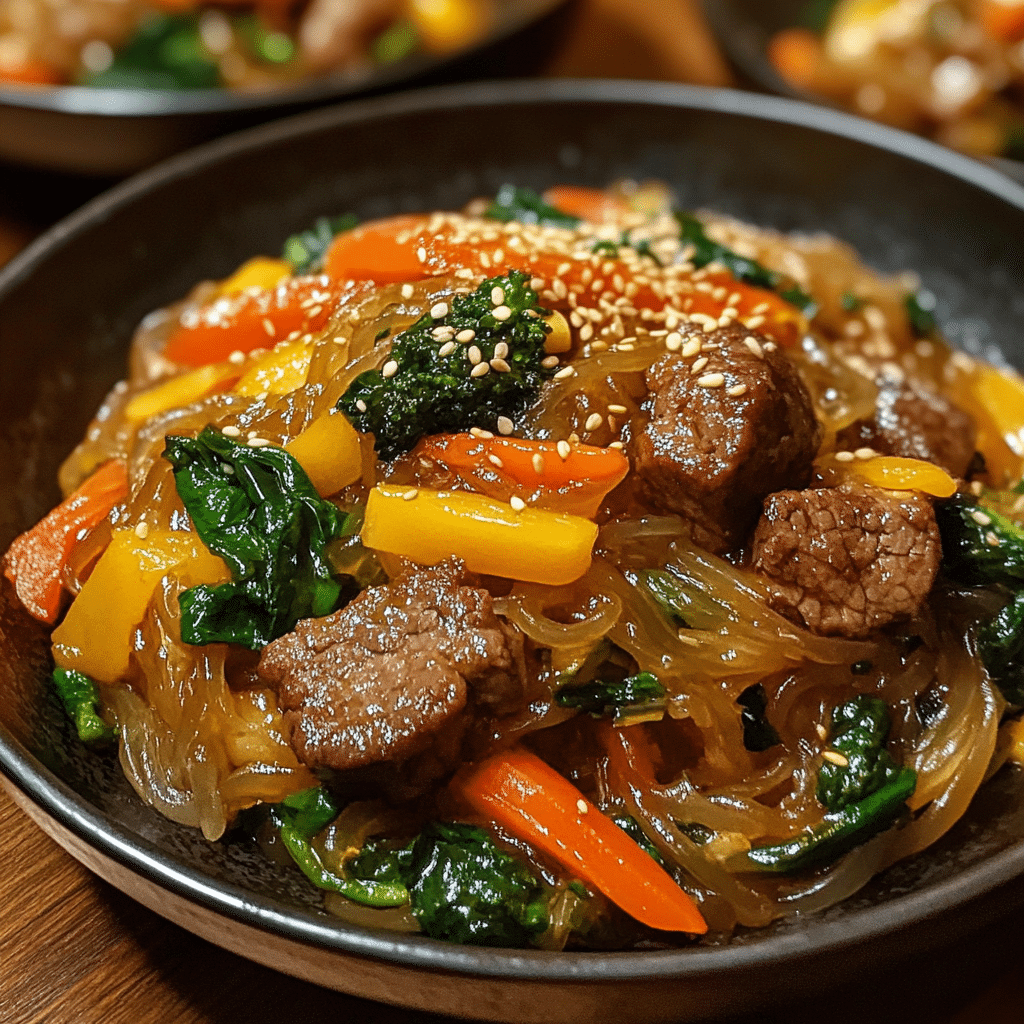
Tips for Making the Recipe
- Do Not Overcook the Noodles: Glass noodles cook quickly, so be sure not to overcook them. Once they’re tender, immediately drain and rinse them under cold water to stop the cooking process.
- Adjust the Sweetness: Feel free to adjust the amount of brown sugar in the sauce depending on how sweet or savory you prefer the dish to be.
- Stir-Fry Over High Heat: When cooking the beef and vegetables, make sure to use high heat to help achieve that crispy, caramelized texture on the meat and vegetables.
- Use Fresh Spinach: Fresh spinach adds a lot of flavor and color to the dish. If you need to substitute, kale can work, but be sure to cook it longer.
How to Serve
Japchae is delicious when served on its own, but it also pairs wonderfully with other Korean dishes such as kimchi, bulgogi, or grilled vegetables. You can enjoy it as a standalone dish or alongside rice for a more filling meal. For a cold version, let the Japchae cool and refrigerate it for a refreshing side dish at barbecues or potlucks.
Make Ahead and Storage
Storing Leftovers
Store any leftover Japchae in an airtight container in the refrigerator for up to 3 days. The noodles and vegetables will absorb more of the sauce as they sit, which enhances the flavors. To reheat, simply toss it in a skillet with a little sesame oil over low heat until warmed through.
Freezing
Japchae can be frozen for up to 1 month. However, the texture of the noodles may change once frozen and thawed. To freeze, portion out the Japchae into freezer-safe containers or bags, and reheat on the stovetop or in the microwave when ready to serve.
Reheating
To reheat, warm the Japchae in a skillet over medium heat, adding a small amount of soy sauce or water to help loosen the noodles and sauce. Stir occasionally until fully heated.
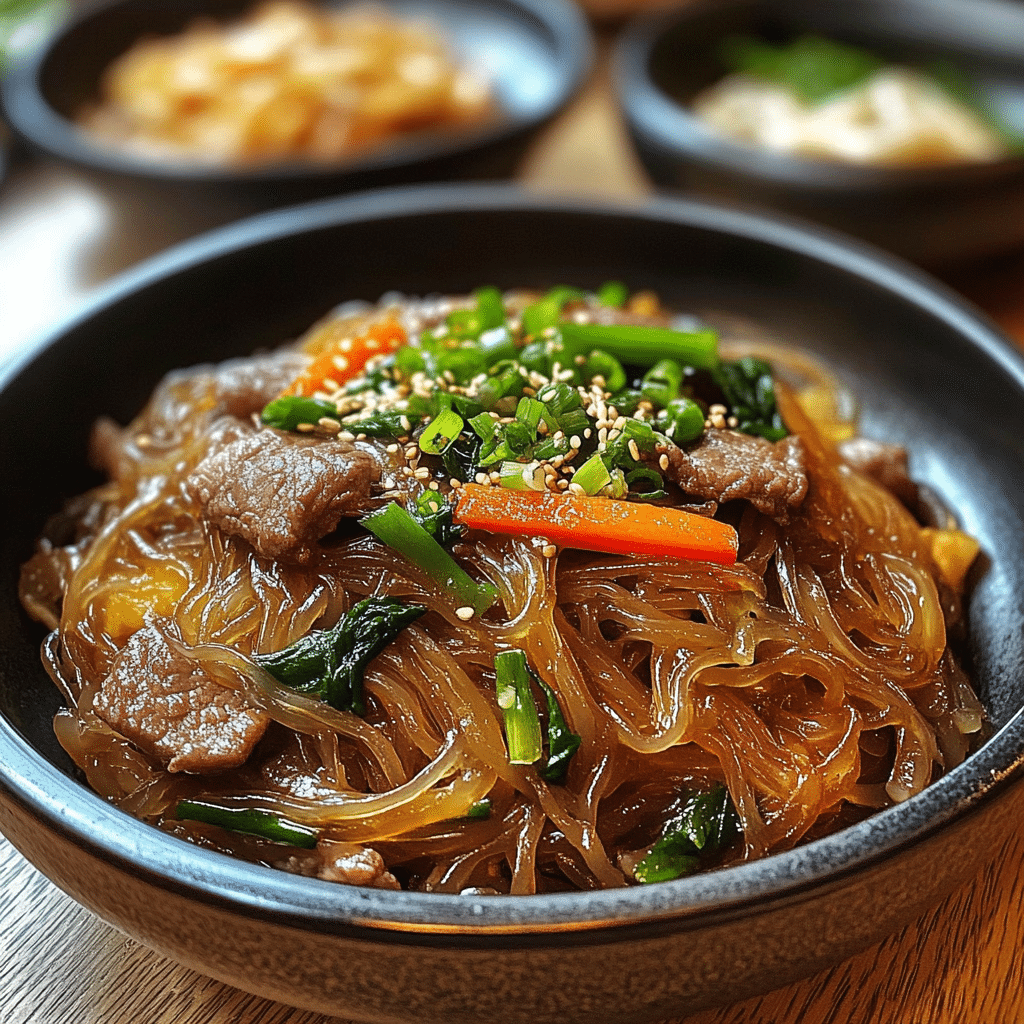
FAQs
1. Can I use a different type of noodle?
Yes, if you can’t find sweet potato noodles, you can use other types of noodles such as rice noodles or soba noodles, though the texture will be slightly different.
2. Can I make this dish vegetarian?
Yes, simply replace the meat with tofu or extra vegetables, and it will be a delicious vegetarian dish.
3. Can I make Japchae in advance?
Yes, Japchae can be made ahead of time. It keeps well in the refrigerator for up to 3 days and actually improves in flavor as it sits.
4. Can I add extra vegetables?
Absolutely! Feel free to add bell peppers, mushrooms, or zucchini to the dish for extra flavor and texture.
5. How do I prevent the noodles from sticking together?
To prevent the noodles from sticking, rinse them under cold water after cooking and toss them with a bit of sesame oil to keep them separated.
6. Can I use frozen spinach instead of fresh?
Fresh spinach is preferred for its flavor and texture, but if you use frozen spinach, make sure to thaw and drain it thoroughly before adding it to the dish.
7. How can I make this dish spicier?
Add red pepper flakes, gochujang, or fresh chili peppers to the sauce for a spicy version of Japchae.
8. Can I use a different protein besides beef?
Yes, you can substitute the beef with chicken, shrimp, tofu, or any protein of your choice.
9. Can I use gluten-free soy sauce?
Yes, if you need the dish to be gluten-free, use tamari instead of regular soy sauce.
10. Can I make Japchae without sesame oil?
While sesame oil adds a unique flavor, you can substitute it with vegetable or olive oil if necessary, though the dish may lack some of its signature taste.
Conclusion
Japchae is a versatile, vibrant, and flavorful dish that combines chewy glass noodles, tender beef, and a medley of vegetables in a sweet and savory sauce. Whether you make it with beef, chicken, tofu, or shrimp, it’s a quick and satisfying meal that can be enjoyed for lunch, dinner, or even as a cold side dish. With simple ingredients and an easy preparation method, this dish is sure to become a favorite in your recipe rotation.
Print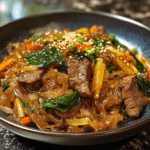
Japchae
- Total Time: 35 minutes
- Yield: 4 servings 1x
Description
Japchae is a delicious and savory Korean dish made with chewy sweet potato noodles, sautéed vegetables, and your choice of protein, all tossed in a flavorful soy-based sauce. This stir-fry is the perfect balance of textures and flavors, making it an irresistible meal for any occasion.
Ingredients
- 2 lb thin-sliced beef (or substitute with chicken, tofu, or shrimp)
- 1 lb Korean sweet potato noodles (glass noodles)
- 3 medium carrots, julienned
- 1 large white onion, thinly sliced
- ½ bunch green onions, chopped
- 6 garlic cloves, minced
- ½ lb spinach leaves
- 4 tbsp sesame oil (divided)
- 1 tbsp olive oil
- 6 tbsp soy sauce (or tamari for gluten-free)
- 3 tbsp brown sugar
Instructions
-
Cook the Noodles:
Bring water to a boil in a large pot with a drizzle of olive oil. Add the sweet potato noodles and cook for 5-6 minutes. Drain and set aside. -
Cook the Beef:
In a skillet over high heat, cook the beef until browned. Season with half of the soy sauce, sesame oil, and brown sugar while cooking. Set the cooked beef aside. -
Sauté the Vegetables:
In another skillet, heat the olive oil. Add the julienned carrots and onion, cooking until softened. Add the remaining soy sauce, sesame oil, and brown sugar. Mix in the garlic and green onions, then cook for another minute. -
Add the Spinach:
Add the spinach leaves and stir until wilted. -
Combine Ingredients:
Add the cooked beef and all vegetables to the noodles. Toss all ingredients well in a large bowl. -
Serve:
Serve the Japchae warm, garnished with extra green onions if desired.
Notes
- Feel free to substitute the beef with chicken, tofu, or shrimp for a different protein option.
- You can add other vegetables like bell peppers or mushrooms for extra flavor and texture.
- Japchae can be made ahead of time and stored in the refrigerator for a few days.
- Prep Time: 15 minutes
- Cook Time: 20 minutes
- Category: Main Course
- Method: Stovetop
- Cuisine: Korean

